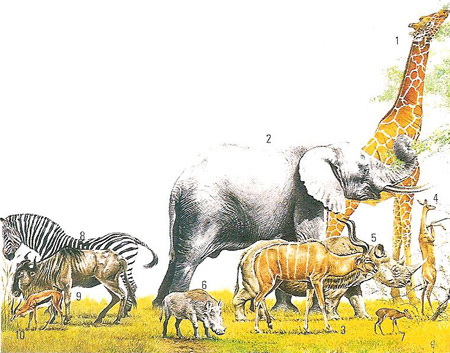herbivore

'Herbivore' is a dietary classification of the animal kingdom; it includes all animals which feed exclusively on plant materials. The term is most often applied to mammals, especially ungulates. Mammalian herbivores are characterized by broad molars and blunt-edged teeth, which they use to pull, cut, and grind their food. Their digestive systems are adapted to the assimilation of cellulose. Preyed on by many carnivores, herbivores form the lower links (primary consumers) of food chains.
Mammalian herbivores may conveniently share a habitat without competing for resources. On the African plains (see illustration), giraffes (1) browse in branches up to 6 meters (20 feet) above the ground. Elephants (2) can browse tree canopies, using their trunks to pluck off vegetation. Eland (3) attack the middle branches with their horns, twisting twigs to break them off, while gerenuk (4) stand on their hind legs to reach higher branches. The black rhino (5) uses its hook-like upper lip to feed on bark, twigs, and leaves (white rhinos have lengthened skulls and broad lips for grazing the short grasses that they favor). The wart hog (6) and dik-dik (7) eat buds and flowers, and will also dig up roots and tubers. Such sharing of a single resource also occurs among grazers. Migrating zebra (8) crop the taller, coarse grasses; wildebeest (9) feed on the leafy center layer, allowing small gazelles (10) to reach the tender new shoots.


